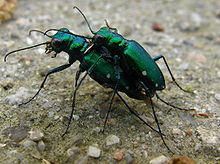Six-point tiger beetle
| Six-point tiger beetle | ||||||||||||
|---|---|---|---|---|---|---|---|---|---|---|---|---|

Six- point tiger beetle ( Cicindela sexguttata ) |
||||||||||||
| Systematics | ||||||||||||
|
||||||||||||
| Scientific name | ||||||||||||
| Cicindela sexguttata | ||||||||||||
| Fabricius , 1775 |
The six-point tiger beetle ( Cicindela sexguttata ) is a beetle from the subfamily of the tiger beetles (Cicindelinae). It is common in North America.
features
Beetle
The beetles reach a body length of 12 to 14 millimeters. They are bright metallic green to blue-green. The hue also depends on the perspective of the viewer or photographer. This tiger beetle is named after six small white dots on the outer rear edge of the wing . Occasionally specimens have fewer points on the wing-coverts or the points are missing entirely. In the states of the Midwest of the USA there is a blue-violet iridescent variety (biology) without a dot drawing. No other tiger beetle looks like this species.
The white mandibles on the front of the head , which clasp one above the other in a scissor shape, and the large hemispherical compound eyes are striking . Both characteristics distinguish this beetle as a predator , which often lies in wait in the sun and waits for prey.
larva
The third larval stage is 20 to 24 millimeters long. On the head and the neck shield these larvae light brown hair, while those of similar types of larvae are white. The pronotum is not yet shiny metallic and has no colored markings like that of the larva of Cicindela formosa generosa .
Occurrence
They are found in the deciduous deciduous forests of southeast Canada and the eastern United States. In Canada it extends from the west bank of Lake Winnipeg over southern Ontario and southern Québec to Nova Scotia in the east. In the United States, the six-point tiger beetle is native to all states between the New England states and North Dakota in the north and Florida and Texas in the south. You can find it on dirt roads and lawns . Unlike other tiger beetles that can be found on sunny open areas such as sand pits, it loves shade.
Way of life
The development cycle of this tiger beetle is around two years. The female lays the eggs in June or early July in sandy or clayey soil, which, unlike the habitats preferred by other tiger beetles , is covered by leaves and can have a large amount of humus. The larvae hatch and reach the third instar in autumn. Then they overwinter and only pupate in July of the following year. The metamorphosis will be completed in August. After that, the beetles usually overwinter in the ground where they pupated. They can only be seen in the late summer of the same year in the south of their distribution area; they usually only show up in open forest clearings and felling in the next spring . Only then do they reach sexual maturity. They can live up to five years and overwinter under pieces of bark or leaves.
These tiger beetles feed on insects. To do this, they sit in a warm place on a piece of dead wood or a stone. They also notice the approach of a larger living being from a distance. They flee and run or fly quickly a few meters to a hiding place.
Systematics and taxonomy
The six-point tiger beetle was first described in 1775 by Johann Christian Fabricius under the name Cicindela sex guttata in his work Systema insectorum . The ground beetle genus Cicindela had already been listed in Carl von Linné's Systema naturae since 1758 .
literature
- Johann Christian Fabricius : I. Eleuterata - Cicindela. 10. C. sex guttata. In: Systema entomologiae: sistens insectorvm classes, ordines, genera, species, adiectis synonymis, locis, descriptionibus, observationeibus. Flensburg / Leipzig 1775, p. 226 ( digitized version ).
- Jonathan G. Leonard, Ross T. Bell: Northeastern Tiger Beetles: A Field Guide to Tiger Beetles of New England and Eastern Canada. CRC Press, 1999, ISBN 0-84931-915-3 , pp. 40-45.
Individual evidence
- ^ A b Jonathan G. Leonard and Ross T. Bell: Northeastern Tiger Beetles: A Field Guide to Tiger Beetles of New England and Eastern Canada. CRC Press, 1999, pp. 40-45, ISBN 0-84931-915-3
- ↑ a b Cicindela sexguttata ( Memento of the original from November 19, 2003 in the web archive archive.today ) Info: The archive link was automatically inserted and not yet checked. Please check the original and archive link according to the instructions and then remove this notice. , Description on the website of the University of Connecticut (chapter, English)
- ↑ Tiger Beetles of Ontario , Tiger Beetle on the pages of the University of Guelph , Ontario (1st paragraph, English)
Web links
- Cicindela sexguttata , description page on BugGuide.net
- Cicindela sexguttata , description on the website of the University of Connecticut , USA
- Cicindela sexguttata , tiger beetle on the pages of the University in Guelph , Ontario, Canada

